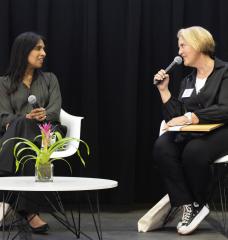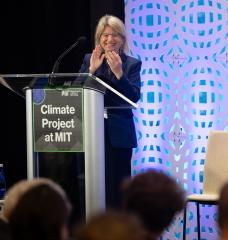
On April 25, MIT was proud to host a Climate Night where Vice President for Research Maria Zuber, MIT Energy Initiative Director Bob Armstrong and Environmental Solutions Initiative Director John Fernández discussed their experiences working on climate issues at MIT. Audience members submitted more questions at that event than time allowed the panel to answer. Over the next few weeks, the VPR office, the Energy Initiative, and the Environmental Solutions Initiative will be posting responses to questions not addressed at the event.
Some questions have been combined or edited for clarity and concision.
Just as climate change increases the probability of extreme weather events, could greater frequency of extreme weather events increase the probability of an extreme political event like passage of strong carbon pricing legislation in the 116th Congress?
From the office of the Vice President for Research: It is highly unlikely that both houses of Congress will pass such legislation during the current session. That said, there are signs in both the Democratic and Republican parties that the issue of climate is rising in saliency. Extreme weather events are probably a factor in this change in political climate, as are the increasingly serious warnings such as last fall's IPCC report and U.S. National Climate Assessment. Earlier social movements that have culminated in major change—civil rights, women’s rights, LGBTQ rights—have taken decades of gradually increasing awareness to produce legislative and judicial change. This is one reason why it is important to continue vigorous public advocacy and activism around climate: our best science-based projections suggest that the planet and its species don’t have decades for humans to change our carbon-emitting behaviors.
Should the growing gap between last fall’s IPCC “45% emissions reduction by 2030” target and 2018’s increased GHG emissions force a rethink about how we can all go bigger in our climate action?
From the office of the MIT Environmental Solutions Initiative: It should and it must! While it's encouraging that (nearly) the entire world has finally acknowledged the scale of the problem and is willing to pledge itself to emissions reduction targets, if emissions nonetheless continue to rise, then plainly we are far from holding ourselves accountable to those pledges. However, let’s take a moment to consider the phrase, "how we can all go bigger in our climate action." It's a worthy thing to take individual actions to reduce our carbon footprints: changing our transportation habits, our diets, our purchasing choices, our energy use. But carrying this gnawing personal guilt about the small-scale ways we all contribute to climate change is misleading about our central predicament. Climate change is a global, socio-technical problem. It is a consequence of the deployment of large-scale fossil energy technology by industry and government. Our increasing emissions are a clear indication that there has not been a global decoupling of economic growth from emissions because fossil energy continues to be the world’s dominant driver of development. So yes, our still-increasing emissions should "force a rethink" of our actions—but we have to think of those actions as part of a larger social change and not merely a personal one. Extraordinary individuals and the collective imagination are bringing new life to alternative visions for a better future, from the worldwide school strikes for climate, to the Sunrise Movement bringing climate change to the center of our politics in the U.S., to the lightning successes of Extinction Rebellion in the U.K. This is part of the rethink we need: how we can all work to make meeting and exceeding those IPCC targets the central mission of our governments, and how we can meet our societal failure on climate change with new society-wide action. We also need a rethink and bold action as we provide for basic human needs through economic growth and development in a low-carbon and ultimately net-zero-carbon world.
Virtually all scenarios for staying under 2 degrees Celsius of global warming require pulling CO2 out of the atmosphere soon. This is a massive engineering challenge. What is MIT, as one of the world’s leading engineering institutions, doing to support the development of negative emissions technologies?
From the office of the MIT Energy Initiative: MIT has a number of efforts focused on negative emissions technologies. Numerous faculty members are conducting research through the MIT Energy Initiative's Low-Carbon Energy Center for Carbon Capture, Utilization, and Storage, on topics including metal-organic frameworks, electrochemical CO2 fixation, geochemical processes, and more. The center facilitates in-depth interactions between industry, government, and academia; multiple industrial sectors; and diverse academic disciplines, to move new ideas into the world at scale. (You can read more about the center's work here.) Bioenergy, another field researchers are investigating at MIT, can also be effective as a negative emissions strategy: as plants grow, they remove CO2 from the air; when plants are combusted to produce energy, CO2 is also produced but could be captured to keep emissions out of the atmosphere. For a deeper dive into the various technologies for achieving negative carbon emissions, listen to MITEI’s podcast episode on this subject.
How does MIT think about the equity impacts of sustainable development projects, such as new public transportation infrastructure? In ethical, political, and technological terms, how do we ensure that equity drives sustainability, and is not tacked on as an afterthought?
From the office of the MIT Environmental Solutions Initiative: In imagining a world that mounts an adequate response to the climate crisis, it is important to demand not only a rapid and sufficient response, but also a just and equitable one. This will be far easier if we take proactive steps to prevent the worst impacts of climate change, and not reactive steps to survive them. A massive expansion of public transportation reduces our fossil fuel consumption, and better serves communities that need more access to jobs and services. Dense urban cores reduce energy use, and provide a larger stock of affordable housing. A swift transition to renewable power cleans our energy grid and our air and water, pollution of which disproportionately affects the most vulnerable. By contrast, a slow and halting adaptation to a changed world is sure to exacerbate inequality: consider the indigenous populations on the coasts of Alaska and Louisiana already being displaced from their homes without the support they need to rebuild. Policy planners need to think deeply and in detail about how climate action can reduce rather than widen social and economic disparities—as in ESI's project advising New York City on equitable resilience connected with the planned return of certain low-lying areas to wetlands. An important effort is being made by researchers at MIT and elsewhere to couple social and economic priorities with environmental and ecological concerns, using the Sustainable Development Goals of the United Nations as a defining framework. Equitable resilience, the social cost of carbon emissions, co-benefits of mitigation, the future of work, are all intended to capture the full benefits and costs of low-carbon transitions. Providing for a low-carbon future will only succeed if we meet global development challenges. But ultimately, we cannot have a just and equitable response to climate change unless it is also rapid and sufficient to meet the challenge.
How fast and drastic will climate change be?
From the office of the Vice President for Research: This depends on several factors. How quickly and broadly are available options, such as conservation and renewables, adopted? How quickly are advances in technologies such as battery storage and carbon capture achieved and brought to scale? Do political forces coalesce around carbon pricing, and are the prices set at a high enough level to influence choices? Also, keep in mind that the speed and severity of climate change will be different in different parts of the world, with coastal and equatorial areas suffering more severe effects sooner. Finally, it is important to emphasize that there are sufficient uncertainties about both the climate system and human responses to it to make any answer to this question tentative and highly qualified. What is clear is that the more greenhouse gases we emit into the atmosphere, the more rapid and drastic the effects of climate change will be, so in a very real way, the answer is up to us.






